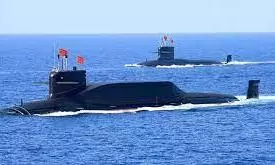
China's nuclear submarine suffers catastrophic Failure, 55 dead: report
text_fieldsReports have emerged suggesting that a nuclear-powered submarine belonging to China suffered a catastrophic failure, resulting in the tragic loss of 55 lives.
These revelations, originating from leaked British intelligence reports, detail an incident that occurred in the Yellow Sea on August 21.
China has denied the loss of the submarine, and Taiwan has also refuted these claims. Nonetheless, the British intelligence report identifies the PLA Navy submarine as 093-417 and states that it encountered a catastrophic failure that led to the poisoning of the crew.
The captain and 21 officers are reported to have lost their lives in this tragic incident.
According to The Times, the vessel ran out of oxygen in the vicinity of Shandong province, located north of Shanghai. The submarine became entangled in seabed defences that were ostensibly set up by Chinese naval forces.
The report suggests that the submarine struck a chain and anchor obstacle designed to ensnare US and allied submarines, resulting in system failures that required six hours to repair and resurface the vessel. The onboard oxygen system malfunctioned and poisoned the crew following the catastrophic failure.
British intelligence officials, quoted in the report, have attributed the cause of death to hypoxia, a condition arising from a lack of oxygen due to a system fault on the submarine.
These intelligence findings, classified at a high level, are expected to prompt a leak inquiry. The incident involving the Shang-class submarine had been the subject of rumours circulating on social media for over a month before the official reports emerged, all of which had been previously denied by Beijing.
China is reported to possess six Type-093 attack submarines, characterised by a displacement of 6,096 tonnes and armed with 553mm torpedoes. These nuclear-powered submarines, designed for reduced acoustic signatures compared to earlier models, have been in service for approximately the past 15 years.























